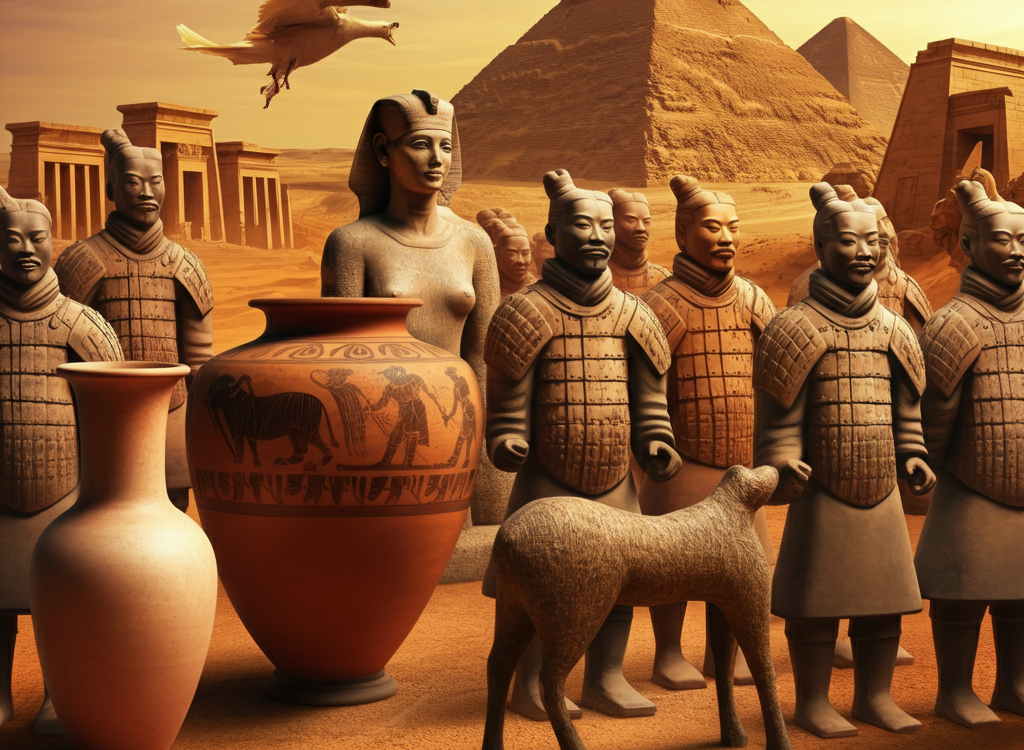Art is humanity’s most enduring storyteller. Ancient art, spanning from primitive cave drawings to intricate stone sculptures, provides a captivating insight into the thoughts, values, and daily lives of our forebearers. Apart from its beauty, ancient art carries profound historical and cultural significance, presenting us with enduring narratives that are imbued in each stroke of the brush and mark of the chisel.
Whether you’ve marveled at the grandeur of the Pyramids of Giza or admired the intricate patterns of Greek pottery, ancient art bridges the gap between the past and present, teaching us lessons about creativity, resilience, and shared human experiences. Join us on a journey to appreciate the beauty, importance, and relevance of ancient artwork and discover how you can engage with this captivating part of our shared history.
What Makes Ancient Artz Unique?
Ancient art is far more than just creative expression—it’s a window into the soul of civilizations that shaped the world as we know it. These artifacts convey values, beliefs, and achievements while showcasing remarkable craftsmanship across cultures and eras. Here are the key attributes that set it apart:
- Timeless Beauty
- Ancient art is celebrated for its harmonious designs, precise execution, and enduring emotional resonance. These creations demonstrate that creativity was as central to survival as technical innovation.
- Cultural Significance
- Each work reflects the values and priorities of the community that created it, whether it’s the spiritual themes in Mayan art or the mythological narratives in Hellenistic sculptures. The art serves as both a cultural record and a way to preserve their collective identity.
- Technological Feats
From the intricate carvings in Angkor Wat to the massive scale of Egyptian obelisks, ancient art is a testament to humanity’s capacity to innovate. These pieces often required advanced tools, calculations, and cooperation among skilled artisans.
Through ancient art, we connect with the ingenuity and spirit of the civilizations that came before us, reminding us that creativity has always been at the heart of human existence.
Unveiling the Historical Importance of Ancient Art
The historical value of ancient art lies in its ability to document societal evolution. These masterpieces aren’t just impressive for their aesthetic qualities—they reveal stories about politics, religion, and daily life that textual records may not fully capture.
1. Spiritual Expression
Much of ancient art was created to honor deities, reflect cosmological beliefs, or preserve spiritual practices. For example:
- Egyptian Tomb Paintings depict vivid scenes of the afterlife, suggesting the Egyptians’ deep reverence for immortality.
- Mayan Temples showcase carvings of rulers as divine mediators between gods and people.
2. Symbols of Power
From monumental ziggurats to grand statues of rulers, many works served as political tools to exalt leaders. The colossal Hammurabi Code Stele, for instance, used art to chronicle laws while solidifying the king’s authority.
3. Documenting Everyday Life
Artifacts such as Roman mosaics or Greek vases often depicted daily activities, including harvests or religious gatherings. These small, personalized glimpses into day-to-day existence continue to shape our understanding of how people lived centuries ago.
By studying these historical artifacts, we open doors to how societies thrived and evolved, preserving memories of ancient peoples who have shaped our cultural DNA.
Exploring Cultural Diversity Through Ancient Art
Ancient art spans the globe, with each culture bringing its unique voice to the creative conversation. Here’s a glimpse into how different civilizations expressed themselves artistically:
1. Egyptian art:
Known for its symmetry and grandeur, Egyptian art often blended spirituality with stylized realism, creating a unique blend of the two. Masterpieces such as the Mask of Tutankhamun and hieroglyphic murals highlight their sophistication.
2. Greek and Roman Contributions:
The Greeks celebrated the human form through sculptures of gods and athletes, like the iconic Discobolus (Discus Thrower). The Romans later adopted Greek techniques, incorporating realism into portraits and engineering magnificent structures, such as the Colosseum.
3. Asian art:
From China’s silk scroll paintings to India’s Buddhist carvings, Asia’s ancient art reflects deep spiritual connections. Artifacts like the Terracotta Army showcase artistic ambition paired with military precision.
4. Mesoamerican Art:
The ancient Mayan and Aztec civilizations constructed impressive pyramids, intricate symbols, and ceremonial objects that showcased their profound knowledge of cosmology and science.
5. African Masks and Carvings:
Ancient African art was deeply integrated with communal rituals. Masks from West Africa were not only a visual spectacle but also spiritual vessels, bridging the physical and metaphysical realms.
This rich variety reflects how societies adapted artistic expression to suit their beliefs, environment, and resources, leaving behind vivid testimonies for future generations.
Modern Relevance of Ancient Art
Despite its age, ancient art remains profoundly relevant, holding lessons and inspirations that continue to shape our world today.
Art and Design Inspirations:
Modern creatives often find their muse in the timeless masterpieces of the past. Egyptian motifs, Greek architectural symmetry, and Roman fresco styles still influence creators in fashion, interior design, and technology.
Preservation Efforts:
Artifacts from ancient cultures are carefully conserved in museums around the world, providing future generations with a tangible connection to the past.
Cultural Heritage Awareness:
The enduring relevance of ancient art underscores the importance of cultural heritage. Protecting these works—whether through repatriation debates or high-tech restoration—has become both a moral obligation and a global priority.
How to Connect and Experience Ancient Art
Want to immerse yourself in the timeless world of ancient art? Here are practical ways to explore its beauty and significance:
1. Visit World-Famous Sites
- Experience the wonder of the Pyramids of Giza in Egypt or the mystical carvings of the Ajanta Caves in India.
- Walk through history at the Acropolis of Athens, where classical Greek sculpture shines.
2. Tour Museums
Renowned institutions like the Louvre, British Museum, and the Met preserve artifacts such as the Rosetta Stone and Parthenon Marbles. Many museums also host interactive exhibitions for an immersive experience.
3. Learn Through Technology
Online platforms now offer virtual tours of historic sites and museums. From the comfort of your home, you can explore ancient art with new accessibility.
4. Try Ancient Art Techniques
Get hands-on by reviving ancient practices like pottery, fresco painting, or weaving. Many art workshops bring these timeless techniques to life in a fun, educational way.
By engaging with ancient art, you’ll not only enrich your understanding of human creativity but also contribute to its preservation for future generations.
Iconic Examples of Ancient Art to Know
These masterpieces have forever shaped the cultural landscape:
- The Venus of Willendorf (Austria): A 25,000-year-old symbol of fertility.
- The Great Wall of China (China): A blend of engineering and artistic ambition.
- The Parthenon Marbles (Greece): Dynamic representations of mythological tales.
- The Terracotta Army (China): Over 8,000 life-sized statues commemorating Emperor Qin Shi Huang.
Each artifact is more than just art—it is a story etched in stone, clay, and paint.
Final Thoughts on Ancient Artz
Ancient Arts is a celebration of human resilience, creativity, and the pursuit of meaning beyond the mundane. These works remind us of our shared heritage and offer pathways to a deeper understanding of ourselves.

